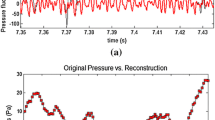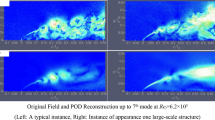Abstract
Time periodic wall parallel Lorentz forces have been used to excite the separated flow on the suction side of an inclined flat plate. Experiments for a Reynolds number of 104 and an angle of attack of α = 13° are reported. The controlled flow is characterised by a small number of relatively large scale vortices, which are related to the control mechanism. The influence of the main parameters, i.e. the excitation frequency, amplitude and wave form on the suction side flow structures was investigated by analysing time resolved particle image velocimetry (TR-PIV) measurements using continuous wavelet analysis for vortex detection and characterisation. Statistical analysis of the coherent structures of the flow was performed on a large amount of data samples.













Similar content being viewed by others
References
Adrian RJ (1996) Stochastic estimation of the structure of turbulent fields. In: Bonnet JP (ed) Eddy structure identification. Springer, New York, pp 145–195
Boeuf J, Lagmich Y, Unfer T, Callegari T, Pitchford L (2007) Electrohydrodynamic force in dielectric barrier discharge plasma actuators. J Phys D Appl Phys 40:652–662
Bonnet JP, Delville J, Glauser MN, Antonia RA, Bisset DK, Cole DR, Fiedler HE, Garem JH, Hilberg D, Jeong J, Kevlahan NKR, Ukeiley LS, Vincendeau E (1998) Collaborative testing of eddy structure identification methods infree turbulent shear flows. Exp Fluids 25:197–225
Bouras C, Nagib H, Durst F, Heim U (2000) Lift and drag control on a lambda wing using leading-edge slot pulsation of various wave forms. Bull Am Phys Soc 45(9):30
Brown G, Roshko A (1974) On density effects and large structure in turbulent mixing layers. J Fluid Mech 64:775–816
Cierpka C, Weier T, Gerbeth G (2007) Electromagnetic control of separated flows using periodic excitation with different wave forms. Notes Numer Fluid Mech Multidisciplinary Des 95:27–41
Farge M (1992) Wavelet transforms and their applications to turbulence. Annu Rev Fluid Mech 24:395–457
Gad-el Hak M (2000) Flow control: passive, active, and reactive flow management. Cambridge University Press, London
Gailitis A, Lielausis O (1961) On a possibility to reduce the hydrodynamic resistance of a plate in an electrolyte. Appl Magnetohydrodyn Rep Phys Inst 12:143–146 (in Russian)
Greenblatt D, Wygnanski I (2000) The control of flow separation by periodic excitation. Prog Aero Sci 36:487–545
Grienberg E (1961) On determination of properties of some potential fields. Appl Magnetohydrodyn Rep Phys Inst 12:147–154 (in Russian)
Jeong J, Hussain F (1995) On the identification of a vortex. J Fluid Mech 285:69–94
Jukes TN, Choi KS, Johnson GA, Scott SJ (2006) Characterization of surface plasma-induced wall flows trough velocity and temperature measurements. AIAA J 44(4):764–771
Likhanskii AV, Shneider MN, Macheret SO, Miles RB (2007) Modeling of dielectric barrier discharge plasma actuators driven by repetitive nanosecond pulses. Phys Plasmas 14 (Article No. 073501)
Margalit S, Greenblatt D, Seifert A, Wygnanski I (2005) Delta wing stall and roll control using segmented piezoelectric fluidic actuators. J Aircraft 42(3):698–709
Raffel M, Willert C, Kompenhans J (1998) Particle image velocimetry, a practical guide. Springer, Berlin
Rice W (1961) Propulsion system. US Patent 2,997,013
Schram C (2002) Application of wavelet transform in vortical flows. In: VKI LS 2002-04, post-processing of experimantal and numerical data, von Karman Institute for Fluid Dynamics, Belgium
Schram C, Rambaud P, Riethmuller M (2004) Wavelet based eddy structure eduction from a backward facing step flow investigated using particle image velocimetry. Exp Fluids 36:233–245
Seifert A, Greenblatt D, Wygnanski I (2004) Active separation control: an overview of Reynolds and Mach number effects. Aerosp Sci Technol 8:569–582
Shatrov V, Gerbeth G (2007) Magnetohydrodynamic drag reduction and its efficiency. Phys Fluids 19:035109
Sutton G, Sherman A (1965) Engineering magnetohydrodynamics. McGraw Hill, New York
Weier T (2005) Elektromagnetische Strömungskontrolle mit wandparallelen Lorentzkräften in schwach leitfähigen Fluiden. PhD thesis, Technische Universität Dresden, Fakultät Maschinenwesen
Weier T, Gerbeth G (2004) Control of separated flows by time periodic Lorentz forces. Eur J Mech B/Fluids 23:835–849
Weier T, Fey U, Gerbeth G, Mutschke G, Lielausis O, Platacis E (2001) Boundary layer control by means of wall parallel Lorentz forces. Magnetohydrodynamics 37(1/2):177–186
Acknowledgments
Financial support from Deutsche Forschungsgemeinschaft (DFG) in frame of the Collaborative Research Centre (SFB) 609 is gratefully acknowledged.
Author information
Authors and Affiliations
Corresponding author
Rights and permissions
About this article
Cite this article
Cierpka, C., Weier, T. & Gerbeth, G. Evolution of vortex structures in an electromagnetically excited separated flow. Exp Fluids 45, 943–953 (2008). https://doi.org/10.1007/s00348-008-0512-6
Received:
Revised:
Accepted:
Published:
Issue Date:
DOI: https://doi.org/10.1007/s00348-008-0512-6




